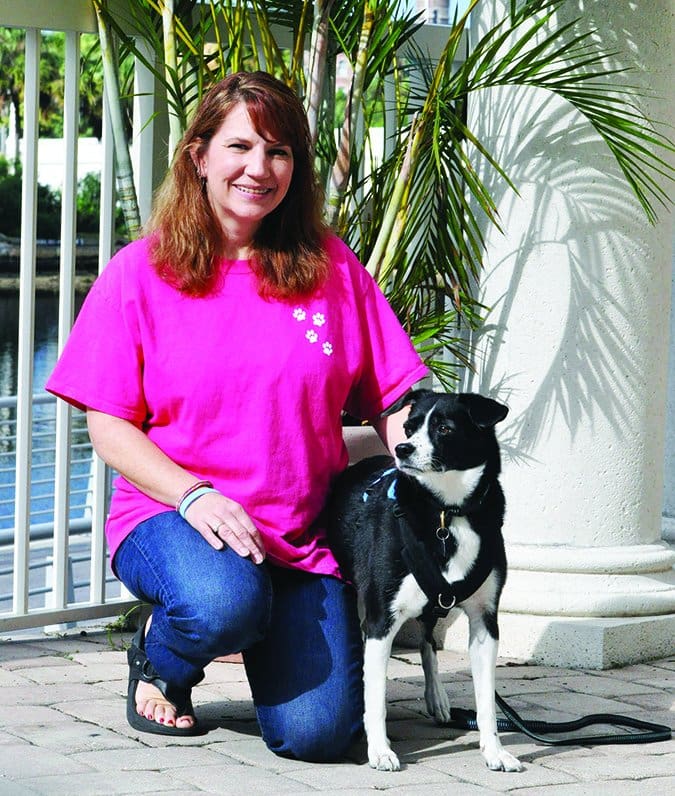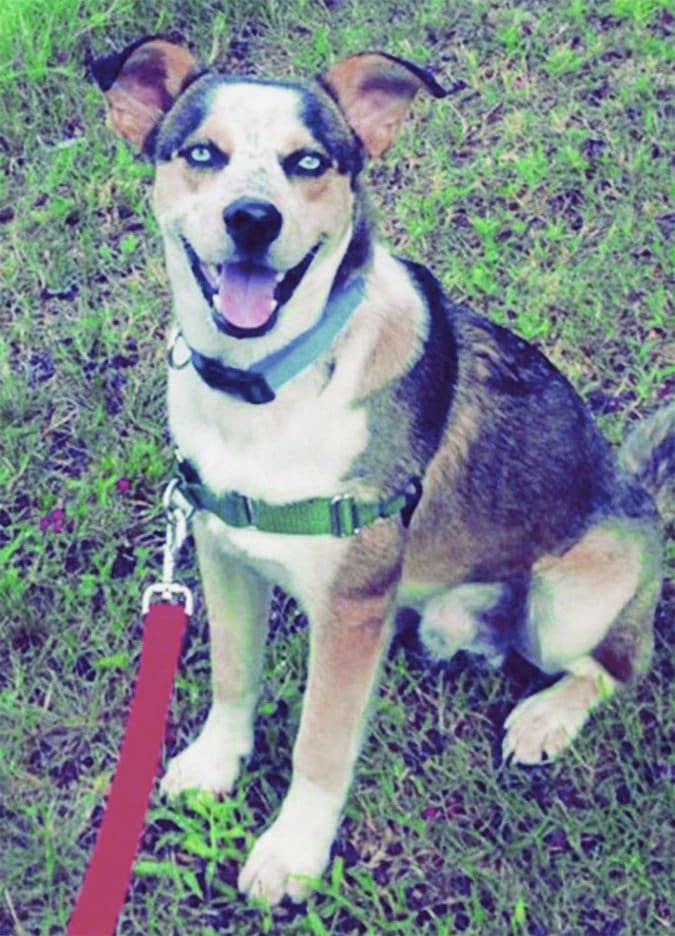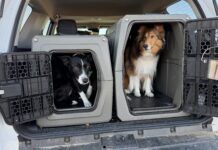I went to prison a few years ago – invited to speak to the participants in Pixie’s Pen Pals dog training program at the Lunenburg Correctional Center in Victoria, Virginia. I was a little nervous, but I needn’t have been: The trainers for the program were professional and capable, the prison staff was welcoming and supportive, and the men in the program were friendly, attentive, and eager to share their experiences and show me their dogs. And the dogs, of course, were wonderful.
I left the prison that day with tears in my eyes and a renewed faith in humans, thinking I should write an article about the redeeming power of interspecies partnerships. Other articles were on the agenda, though, and the impetus for the article faded.

I was at a dog training conference last fall when I bumped into Katie Locks, one of the lead trainers from the Pen Pals program. She reintroduced herself to me, and then asked if I remembered the man sitting next to her. I must have looked blank, because she grinned a little when she introduced me to Rob, one of the now-graduated, former-inmate participants who now works professionally as a dog trainer! After a bit of a conversation, I was much impressed by this intelligent, soft-spoken, gentle man. It was the push I needed to finally write this article.
Some of my other colleagues are also involved with prison dog training programs. Brad and Lisa Waggoner, husband and wife trainers and owners of Cold Nose College in Murphy, North Carolina, have participated in a prison dog training program at the Colwell Probation and Detention Center in Blairsville, Georgia, for the past four years. Like Katie, they get a great sense of accomplishment from their work with the dogs and men in the prison dog training program they volunteer with.
Katie Locks and the Virginia Prison Dog Programs
Katie Locks is the owner of Lucky Dogs Training and More in Amelia Court House, Virginia. Since 2004, she has worked with rescues and individuals to strengthen the bond with dogs through training. She trains for the Southside SPCA as well as Lab Rescue of the Labrador Retriever Club of the Potomac, is a mentor trainer for Animal Behavior College, and is the lead trainer for Pixie’s Pen Pals.
Pen Pals was started in 2001, and operates at four Virginia prisons: Lunenburg Correctional Center, Buckingham Correctional Center, Deerfield Work Center, and Fluvanna Correctional Center for Women. Katie oversees the programs at the first two prisons.
Pat Miller: How, when, and why did you become involved in a prison dog program?
Katie Locks: I have been working in the Virginia prisons with Pixie’s Pen Pals since October 2009. The previous director of the program (then managed by Save Our Shelters, now managed by FETCH a Cure) contacted me and asked if I would be interested in meeting with her and visiting a prison. I jumped at the opportunity to try something new and different.
Pat: Where do the dogs come from that you use in the program? What do you look for in selecting dogs for the program?
Katie: The dogs that I take in to the facilities I oversee come from Southside SPCA in Meherrin, Virginia – a small, private, nonprofit organization run by a small staff and a large network of volunteers in rural central Virginia. I work closely with the Assistant Director, Francee Schuma, and we meet and evaluate dogs regularly. We look for the dogs who are not quite ready to go to adoption events but have a lot to offer. Usually, it’s the “underdog” that I take in. There are no set criteria; we are always hopeful that through patience and a little training we can turn that dog’s future around.
Pat: How are inmates selected for the program?
Katie: I do not select the human participants in the program. They are selected by the liaisons I work with at the prison, and the criteria is pretty strict. The men selected for the program have to be charge-free for two years, cannot have had any animal cruelty-related or sex offenses, and they have to be “model” inmates and be eligible for honor housing.
Once they are part of the program, they must follow the education outline and show respect for the dogs and other handlers. At that point, I have input as to their continued suitability for the program.
At Lunenburg there are generally 12 men and six dogs in the program at any given time, and at Buckingham, four men and two dogs.
Pat: Do many inmates choose to work with dogs after they are released? Do they stay in touch with you?
Katie: Some do wish to continue, either on a volunteer basis or as a career. For most guys, this has not become a career due to the time it takes to build a business or the difficulty in finding employment with facilities willing to hire them.
I have had a few over the years reach out to me for professional advice and support, and update me on their progress on the outside.
Pat: What are the goals of the program? How does it work?
Katie: It is a full-circle effect. The dogs come into the program because they need a second chance to learn new skills, and the men who train them need a second chance to develop their potential and sense of self-worth. So the goals of the program are to rehabilitate humans and dogs through a mutual system of trust.

The dogs stay with the inmates in their cells. Some facilities have one-man cells and others have two-man cells, but the ratio is two handlers per dog in all facilities.
I go to the facilities once a week to evaluate, monitor, and teach new skills to the handlers. The dogs stay in our program until they are adopted or a long-term foster can be found. The inmates stay in the program as long as they are permitted and continue to meet the criteria of the program.
The men do have ongoing course work and advance to higher skill levels upon completion of each level (i.e., beginner, secondary, and primary handler status). Each level is assigned seven to 10 books and videos which they must read/view. The inmates must write reports, take tests, and pass a skills assessment.
Pat: What do the dogs learn? What training methods are used?
Katie: The first thing the dogs must learn is to trust. Once there is a good rapport and bond with the handler, they begin to learn the basics (sit, down, wait, stay, come, leash walking, crate training, housetraining, good manners.) Once dogs are proficient at the basics, the men are allowed to teach them some fun stuff (roll over, play dead, wave).
We promote only positive training methods using incentives such as food, toys, praise, and access to fun stuff.
Pat: How are dogs placed in homes after they complete the programs? If there a waiting list for adopters? Are the dogs usually easy to place?
Katie: Dogs are posted on the FETCH a Cure website and through Petfinder, and remain in the program until adopted.
I wish there were a waiting list! Some dogs are in the program for far longer than necessary. The dogs themselves are, for the most part, fantastic, but we just don’t have adopters waiting in line.
Pat: What’s your favorite thing about the program?
Katie: I love the fact that dogs who need a little help and humans who need a little help get to help each other, sometimes without realizing the huge impact they have on each other. I have seen many men transform through this program and become responsible, caring individuals who are better able to handle life on the outside because of this program.
Pat: What do you consider your greatest success so far?
Katie: The greatest success is seeing the sense of accomplishment that these men feel when their dog is adopted by a family who is very grateful and appreciative of all their hard work and effort.
This program has changed my life and the way I view people in general. There is good in everyone if you are willing to see it.
Lisa & Brad Waggoner
Lisa Lyle Waggoner, CPDT-KA, PMCT, CSAT, and her husband Brad Waggoner, CPDT-KA, KPA CTP, are the owners of Cold Nose College in Murphy, North Carolina. The Waggoners have been involved with the dog training program, “RESCUED: Saving Detainees and Dogs One Life at a Time,” at the Colwell Probation and Detention Center in Blairsville, Georgia, since it was started four years ago.
Pat: How and why did you become involved in the RESCUED program?
Lisa: My dad was a psychologist in maximum security prisons when I was growing up. He had a PhD in psychology, and lobbied for using positive reinforcement vs. punishment in the rehabilitation of prisoners. There were many times he was a whistleblower, standing up against inmate beatings.
In 2004, while driving to Maryland to attend a week-long dog training instructor course at Peaceable Paws, I drove by a prison and thought of my dad’s work. It was then that I first hoped to one day be involved in a prison dog training program. When Brad and I were approached about implementing a dog training program within the Colwell Probation and Detention Center, it was easy to say “Yes!”
Pat: Where do the dogs used in the program come from?
Brad: The dogs come from two shelter partners of the program, Castoff Pet Rescue and Humane Society Mountain Shelter, both in Blairsville, Georgia. RESCUED is a 10-week program that matches a detainee with a dog in need of care and patient training.
We don’t select the dogs for the program. However, the two groups have done a nice job of selecting dogs who have only general training needs, as opposed to serious behavior issues.
Pat: How are inmates selected for the program?
Brad: The detainees are selected to participate in the program after an extensive application process that includes an essay, a thorough background check of their criminal histories, and an assessment of their institutional behavior. When the detainee has successfully completed the first part of the process, he is interviewed by a panel. After this, the board makes a decision of who will fill the vacant handler positions.
Pat: Do many inmates choose to work with dogs after they are released?
Lisa: There are only two that we know of who initially began working with dogs. One as an employee in a boarding/day care/training facility and the other as a vet assistant.
Pat: Do they stay in touch with you?
Lisa: Many do and it’s a joy to continue hearing from them via email or by staying in touch through Facebook.
Pat: What are the goals of the program?
Lisa: RESCUED is the first dog rescue program within the Georgia Department of Corrections. RESCUED teaches viable job skills that enable the men to gain employment upon re-entry into their communities. As Diane Hassett, superintendent of the facility says, “This gives them a chance of being ‘rescued’ from the revolving door of incarceration.”
The detainees are also taught useful skills and given the privilege of on-the-job training, which helps solidify their foundation as productive citizens.
In addition to positive dog training and a grooming program, the program has expanded to include a number of other programs offered by different organizations. These include a basic animal health class taught by Dr. Patti Barnes and Dr. Dwaine Zagrocki of Union County Pet Hospital, classes in pet first aid and pet CPR taught by Brad, and a variety of classes on building a resume, job search skills, problem-solving, computer skills, small business and money management, and anger management. Also, detainees can earn a certificate in grooming through a course offered by Central Georgia Technical College.
Pat: How does the program work?
Lisa: Three dogs from each shelter partner organization are selected for each 10-week RESCUED program. In June of 2012, the six men and four dogs were housed in a 216-square-foot room, which included six bunks, four dog crates, and additional dog gear. After the successful first year of the program, the Georgia Department of Corrections gave Colwell the permission to expand the program and the space it occupies. The men and the dogs now live together in a 1,100-square-foot dorm that also includes six double bunks, a bathing and a grooming area, and a library of positive dog training books, DVDs, and publications donated by dog trainers from around the United States.
The total number of men varies, though there is always a minimum of six dogs and six handlers, along with two or three mentor detainees. The mentor detainees are men who have completed the previous 10-week program and stay involved until their release date. Colwell is a minimum security and probation detention center, so the stays are much shorter than in maximum security prisons.
We spend one morning a week teaching the participants positive dog training, which includes basic family manners, agility for fun, a two-hour presentation on dog body language and canine communication, and a session on nose work, along with presentations on learning theory, pet first aid, and CPR.
Dogs usually stay in the program for the 10-week session, but if a dog isn’t adopted at the end, the dog often stays in the program until he finds his forever home, though some dogs may go back to the shelter. The two partner groups are responsible for the adoptions.
Sometimes the men in the program adopt the dogs they’ve worked with, though some of them cannot because of life situations upon their release. But finding homes for the dogs is becoming easier now that we have two new shelter partners, and the Georgia Department of Corrections has allowed the facility to have a Facebook page for the program. The Public Affairs Office is also in the midst of putting together a video about the program that will soon be released, which we anticipate will help promote adoptions.
Pat: What do you like about the program?
Lisa: The ability to see the amazing transformation in the men (as well as the dogs). We see their attitudes and their anger melt away as they begin to learn with their dogs. It’s also so incredible to see them realize that positive techniques can be applied to people, too. It’s evident to see that the program has a powerful effect on the men, as demonstrated by the comments I received after last week’s training session:
Detainee Carlton, now a mentor, says, “Mentorship wasn’t what I expected. It was harder. I’ve managed construction crews before, but it was not of this magnitude. It’s expanded my leadership abilities. I now have a different way to teach and lead people.”
Detainee McGraw offered, “It’s been a wonderful learning experience. I wasn’t looking to fall in love with a dog. I was really just looking for a way out of the other dorm, but we’ve all come together. We’ve learned more from the dogs than they have from us, especially patience. These dogs have had a hard life in the shelter and it’s amazing what you can teach them. If they can learn, then we can, too. Anything is possible.”
Detainee Fulkerson chimed in that for him, “It’s been a challenge working with the other people and a challenge for ourselves. We have to set an example. Some of us have a harder time following integrity, but we’ve learned that integrity is about doing the right thing with no one is looking. The dogs want to be loved and we want to be loved.”
And Andrew Holcomb, a former graduate who is now working as a long-haul truck driver, said to me this week via Facebook, “The RESCUED program taught me that there is more to life than myself. I actually care about more than myself now. It changed my outlook on life all together. It taught me how to love and care for others and no matter what, always do the right thing.”
For Brad and me, it just doesn’t get any better than that!
Pat: Is there anything you’d change about the program if you could?
Lisa: Not a thing. We have an amazing team of individuals involved in this program and we all believe we’re making a difference in the lives of the men and the dogs. The superintendent recently put together a proposal to convert the vacant gymnasium (which has never been used) into a new facility where more men and dogs can be in the program, as well as an adoption center where dogs can easily stay and wait for their forever homes if they’re not adopted.
Pat: What do you consider your greatest success so far?
Brad: Everyone involved in the program sees the acceptance and expansion of the program as its greatest success. To date, 74 detainees have completed the program and were released. Of those, 67 percent continue to be productive members of our society.
I’d like to tell other trainers, “If you have a chance to volunteer for such a program, jump on it!” We’re honored to be involved.
Author Pat Miller, CBCC-KA, CPDT-KA, is WDJ’s Training Editor. She and her husband Paul live in Fairplay, Maryland, site of her Peaceable Paws training center, where Pat offers dog-training classes and courses for trainers.





